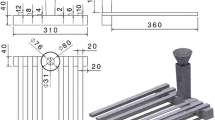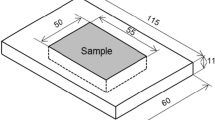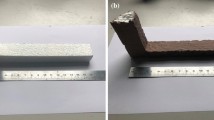Abstract
In this paper, the relationship between the microstructure of coatings and the quality of castings in lost foam casting (LFC) process was investigated. The morphological studies of refractory aggregates were carried out by scanning electron microscopy (SEM). The 3D models of the coating were built based on the dimension data of the refractory aggregate to analyze the differences in microstructure. The coating model was used in finite element simulations to study the flow state of liquid decomposition products in coatings with different microstructures. At the same time, each coating sample was used in multiple casting experiments. Defects at specific locations of the castings were analyzed and statistically counted through optical microscopy. In conclusion, the combination of expanded graphite and bauxite clinker yields the best quality castings in A356 LFC.










Similar content being viewed by others
References
M. Barone, D. Caulk, Analysis of mold filling in lost foam casting of aluminum: method. Inter Metalcast. 2, 29–45 (2008). https://doi.org/10.1007/BF03355431
D. Caulk, Analysis of mold filling in lost foam casting of aluminum: part II-example applications. Inter Metalcast. 3, 7–25 (2009). https://doi.org/10.1007/BF03355438
S.G. Shabestari, M. Divandari, M.H. Ghoncheh, V. Jamali, Interplay among coating thickness, strip size, and thermal and solidification characteristics in A356 lost foam casting alloy. Metal. Mater. Trans. B 48, 2304–2315 (2017). https://doi.org/10.1007/s11663-017-1019-4
S. Acar, K.A. Guler, A preliminary study upon the applicability of the direct water cooling with the lost foam casting process. Inter Metalcast. 15, 88–97 (2021). https://doi.org/10.1007/s40962-020-00420-7
I. Tutuk, S. Acar, K.A. Guler, The application of the direct water cooling process on the lost-foam casting technique to improve microstructural and mechanical properties of A356 alloy. Inter. Metalcast (2023). https://doi.org/10.1007/s40962-022-00950-2
K. Kim, Effect of process parameters on porosity in aluminum lost foam process. J. Mater. Sci. Technol. 21, 681–685 (2005). https://doi.org/10.1080/13640461.1996.11819640
W. Sun, Formation mechanism of gas cavity defects in lost foam iron castings. Int. J. Cast Metals Res. 16, 549–553 (2003). https://doi.org/10.1080/13640461.2003.11819634
H. Zhao, PKs.. Nam, V.L. Richards et al., Thermal decomposition studies of EPS foam, polyurethane foam, and epoxy resin (SLA) as aatterns for investment casting; analysis of hydrogen cyanide (HCN) from thermal degradation of polyurethane foam. Inter. Metalcast. 13, 18–25 (2019). https://doi.org/10.1007/s40962-018-0240-5
T. Kobayashi, Thermal decomposition behavior of expandable pattern including blended metal or metal oxide powder in evaporative pattern casting of Al-Si system alloy. Mater. Trans. 11, 2404–2409 (2003). https://doi.org/10.2320/matertrans.44.2404
T. Maruyama, Effect of coating thickness on the molten metal filling rate of cast iron in the evaporative pattern casting process. Int. J Metalcast. 11, 77–83 (2017). https://doi.org/10.1007/s40962-016-0108-5
K. Kim, Effect of process parameters on porosity in aluminum lost foam process. J. Mater. Sci. Technol. 21, 828–832 (2005)
B. Kang, Density and mechanical properties of aluminum lost foam casting by pressurization during solidification. J. Mater. Sci. Technol. 23, 681–685 (2007)
Y. Akbarzadeh, Microstructure, permeability and rheological behavior of lost foam refractory coatings. Surf. Coat. Tech. 202, 4636–4643 (2008). https://doi.org/10.1016/j.surfcoat.2008.03.036
A.-S. Chang, The strength of coating in the lost foam casting process. Int. J. Cast Metals Res. 12, 251–261 (1999). https://doi.org/10.1080/13640461.2000.11819362
A.S. Chang, T.S. Shih, Permeability of coating in the lost foam casting process. Int. J. Cast Metals Res. 12(4), 263–275 (2000)
D.A. Caulk, A pattern decomposition model for lost foam casting of aluminum: part II—gap mode. AFS Trans. 114, 857 (2006)
D.A. Caulk, A pattern decomposition model for lost foam casting of aluminum: part III—collapse mode. AFS Trans 115, 833 (2007)
D.A. Caulk, A pattern decomposition model for lost foam casting of aluminum: part IV—engulf mode. AFS Trans. 115, 833 (2007)
H.L. Tsai, T.S. Chen, Modeling of evaporative pattern process, part I: metal flow and heat transfer during the filling stage. AFS Trans. 96, 881–890 (1988)
F.C. Chang, H.L. Tsai, Numerical study of fluidity in evaporative pattern process including latent heat effect. AFS Trans. 97, 521–528 (1989)
S.S.S. Abayarathana, H.L. Tsai, Modeling of evaporative pattern process, part II: heat/mass transfer in sand mold and its effect on casting solidification. AFS Trans. 97, 653–660 (1989)
J. Jezierski, The impact of process factors on creating defects, mainly lustrous carbon, during the production of ductile iron using the lost-foam casting (LFC) method. Metals-basel. 10, 1022 (2020). https://doi.org/10.3390/met10081022
M. Khodai, Pressure measurement and some observation in lost foam casting. J. Mater. Process Tech. 206, 1–6 (2008). https://doi.org/10.1016/j.jmatprotec.2007.11.309
J. Aho, On the measurement and modeling of viscosity of polymers at low temperatures. Polym. Test. 27, 35–40 (2007). https://doi.org/10.1016/j.polymertesting.2007.08.004
S.A. Sajjadi, M. Torabi Parizi, H.R. Ezatpour, A. Sedghi, Fabrication of A356 composite reinforced with micro and nano Al2O3 particles by a developed compocasting method and study of its properties. J. Alloy Compd. 511, 226–231 (2012). https://doi.org/10.1016/j.jallcom.2011.08.105
Author information
Authors and Affiliations
Corresponding author
Additional information
Publisher's Note
Springer Nature remains neutral with regard to jurisdictional claims in published maps and institutional affiliations.
Rights and permissions
Springer Nature or its licensor (e.g. a society or other partner) holds exclusive rights to this article under a publishing agreement with the author(s) or other rightsholder(s); author self-archiving of the accepted manuscript version of this article is solely governed by the terms of such publishing agreement and applicable law.
About this article
Cite this article
Sun, C., Cao, Z. & Liu, G. Effect of refractory aggregate shape on the porosity of A356 alloy castings in lost foam casting. Inter Metalcast (2023). https://doi.org/10.1007/s40962-023-01188-2
Received:
Accepted:
Published:
DOI: https://doi.org/10.1007/s40962-023-01188-2




